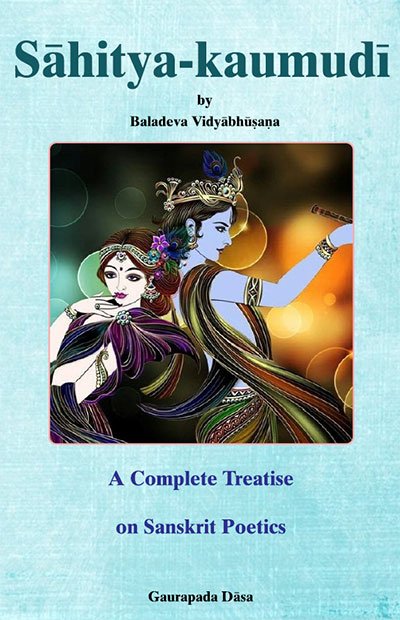Sahitya-kaumudi by Baladeva Vidyabhushana
by Gaurapada Dāsa | 2015 | 234,703 words
Baladeva Vidyabhusana’s Sahitya-kaumudi covers all aspects of poetical theory except the topic of dramaturgy. All the definitions of poetical concepts are taken from Mammata’s Kavya-prakasha, the most authoritative work on Sanskrit poetical rhetoric. Baladeva Vidyabhushana added the eleventh chapter, where he expounds additional ornaments from Visv...
Text 9.7
उदाहरणम्,
udāharaṇam,
This illustrates cheka anuprāsa,
jahāra hariṇākṣīyaṃ kundendu-madhura-smitaiḥ |
kuṇḍalojjvala-gaṇḍa-śrīr vidayaṃ hṛdayaṃ mama ||
jahāra—stole; hariṇa—[are like the eyes of] a doe; akṣī—she whose eyes; iyam—this; kunda—[white like] jasmine; indu—and the moon; madhura—sweet; smitaiḥ—with smiles; kuṇḍala—with earrings; ujjvala—is brilliant (marvelous); gaṇḍa—of whose cheeks; śrīḥ—the splendor; vidayam—mercilessly; hṛdayam—heart; mama—My.
[Kṛṣṇa talks to Subala:] This doe-eyed girl, the splendor of whose cheeks is marvelous with earrings, mercilessly stole My heart with her sweet smiles as white as jasmines and as the moon. atrāsaṃyuktayoḥ saṃyuktayoś cānekasya sakṛt sāmyam.
In this verse, there is one repetition of more than one consonant. Here the cheka anuprāsa occurs between two nonconjoined consonants and between two conjoined consonants.
Commentary:
In every instance of cheka, the sequence of the consonants must be the same. In “jahāra hari,” there is one repetition of h and r, which are not conjoined. In “kundendu,” there is one repetition of the conjoined consonants nd. In “kuṇḍalojjvala-gaṇḍa,” although there is one repetition of the conjoined consonants ṇḍ, there is no cheka anuprāsa proper because the repetition is too far away. And in “vidayaṃ hṛdaya,” there is one repetition of d and y.
This is Mammaṭa’s example of cheka anuprāsa,
tato’ruṇa-parispanda-mandī-kṛta-vapuḥ śaśī |
dadhre kāma-parikṣāma-kāminī-gaṇḍa-pāṇḍutām ||“The moon, made dim by the advent of the sun, assumed the paleness of the cheeks of a passionate woman who had become emaciated by the pang of love” (Kāvya-prakāśa, verse 355).
With this example, Mammaṭa indicates that cheka anuprāsa is not faulty if, for instance, hard phonemes are used in the context of śṛṅgāra-rasa. In his examples, however, Viśvanātha Kavirāja did not mix the type of phonemes.
